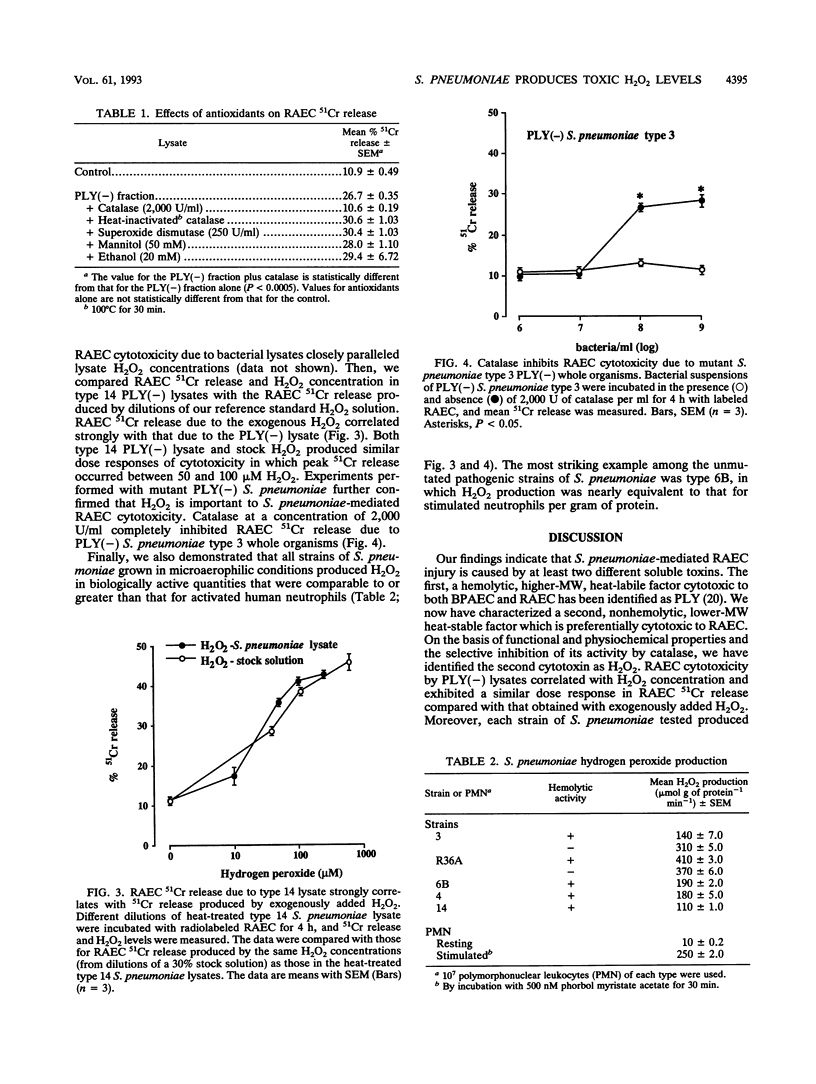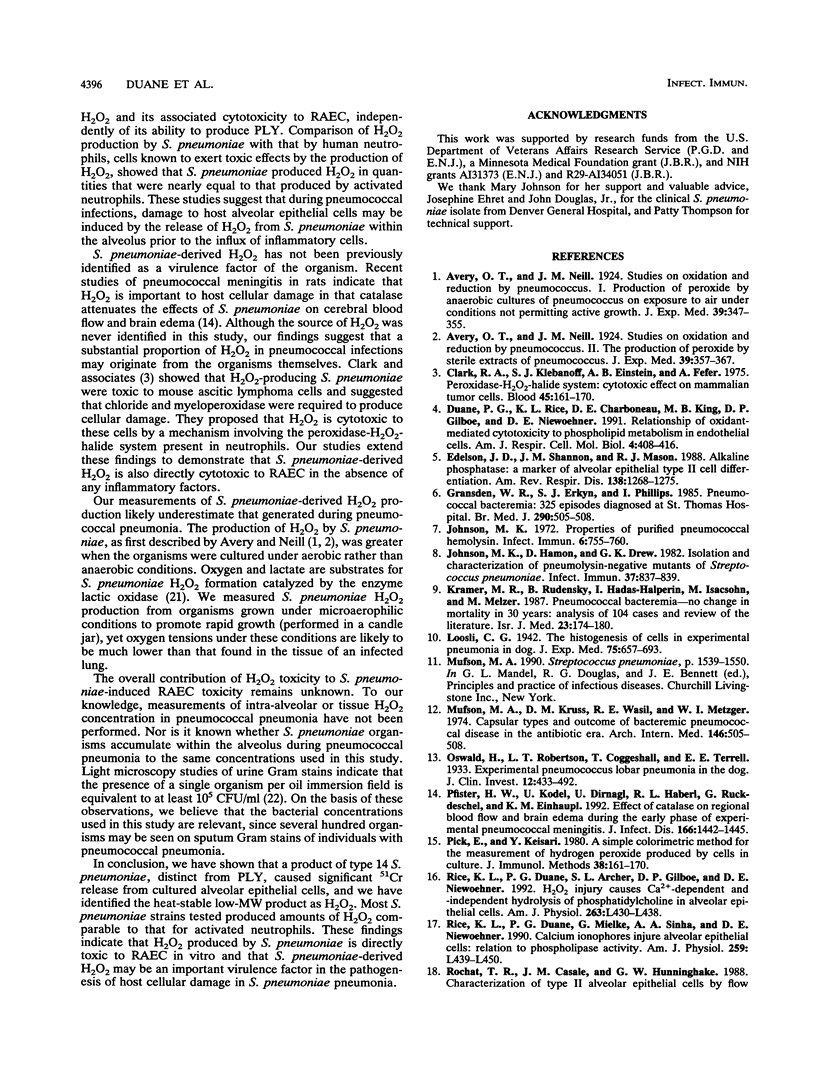Abstract
Streptococcus pneumoniae infections of the lung are associated with significant damage to the alveolar epithelium. Host phagocytes and pneumolysin, a cytolytic toxin of S. pneumoniae, are believed to contribute to this cellular damage, yet experiments in which these elements are absent demonstrate the presence of an additional soluble S. pneumoniae factor that is toxic to alveolar epithelium. We examined the effects of S. pneumoniae-associated alveolar epithelial cell injury by factors other than S. pneumoniae-derived pneumolysin or phagocyte products by exposing cultured rat type II alveolar epithelial cells (RAEC) to S. pneumoniae mutants that lacked pneumolysin activity. We found that mutant pneumolysin-deficient strains of S. pneumoniae produced injury to RAEC similar to that produced by the parent strains. A toxin of type 14 S. pneumoniae was distinguished from pneumolysin by physiochemical (i.e., molecular mass and heat stability) and functional (i.e., hemolytic activity and cytotoxic activity) properties and was identified as hydrogen peroxide. All S. pneumoniae strains tested produced hydrogen peroxide, and in many strains hydrogen peroxide production was comparable to that of activated neutrophils. We conclude that S. pneumoniae produces hydrogen peroxide in concentrations that are cytotoxic to RAEC in vitro and that alveolar epithelial damage due to hydrogen peroxide may be involved in the pathogenesis of host cellular injury in pneumococcal pneumonia.
Full text
PDF





Selected References
These references are in PubMed. This may not be the complete list of references from this article.
- Clark R. A., Klebanoff S. J., Einstein A. B., Fefer A. Peroxidase-H2O2-halide system: Cytotoxic effect on mammalian tumor cells. Blood. 1975 Feb;45(2):161–170. [PubMed] [Google Scholar]
- Duane P. G., Rice K. L., Charboneau D. E., King M. B., Gilboe D. P., Niewoehner D. E. Relationship of oxidant-mediated cytotoxicity to phospholipid metabolism in endothelial cells. Am J Respir Cell Mol Biol. 1991 May;4(5):408–416. doi: 10.1165/ajrcmb/4.5.408. [DOI] [PubMed] [Google Scholar]
- Edelson J. D., Shannon J. M., Mason R. J. Alkaline phosphatase: a marker of alveolar type II cell differentiation. Am Rev Respir Dis. 1988 Nov;138(5):1268–1275. doi: 10.1164/ajrccm/138.5.1268. [DOI] [PubMed] [Google Scholar]
- Gransden W. R., Eykyn S. J., Phillips I. Pneumococcal bacteraemia: 325 episodes diagnosed at St Thomas's Hospital. Br Med J (Clin Res Ed) 1985 Feb 16;290(6467):505–508. doi: 10.1136/bmj.290.6467.505. [DOI] [PMC free article] [PubMed] [Google Scholar]
- Johnson M. K., Hamon D., Drew G. K. Isolation and characterization of pneumolysin-negative mutants of Streptococcus pneumoniae. Infect Immun. 1982 Aug;37(2):837–839. doi: 10.1128/iai.37.2.837-839.1982. [DOI] [PMC free article] [PubMed] [Google Scholar]
- Johnson M. K. Properties of purified pneumococcal hemolysin. Infect Immun. 1972 Nov;6(5):755–760. doi: 10.1128/iai.6.5.755-760.1972. [DOI] [PMC free article] [PubMed] [Google Scholar]
- Kramer M. R., Rudensky B., Hadas-Halperin I., Isacsohn M., Melzer E. Pneumococcal bacteremia--no change in mortality in 30 years: analysis of 104 cases and review of the literature. Isr J Med Sci. 1987 Mar;23(3):174–180. [PubMed] [Google Scholar]
- Mufson M. A., Kruss D. M., Wasil R. E., Metzger W. I. Capsular types and outcome of bacteremic pneumococcal disease in the antibiotic era. Arch Intern Med. 1974 Sep;134(3):505–510. [PubMed] [Google Scholar]
- Pfister H. W., Ködel U., Dirnagl U., Haberl R. L., Ruckdeschel G., Einhäupl K. M. Effect of catalase on regional cerebral blood flow and brain edema during the early phase of experimental pneumococcal meningitis. J Infect Dis. 1992 Dec;166(6):1442–1445. doi: 10.1093/infdis/166.6.1442. [DOI] [PubMed] [Google Scholar]
- Pick E., Keisari Y. A simple colorimetric method for the measurement of hydrogen peroxide produced by cells in culture. J Immunol Methods. 1980;38(1-2):161–170. doi: 10.1016/0022-1759(80)90340-3. [DOI] [PubMed] [Google Scholar]
- Rice K. L., Duane P. G., Archer S. L., Gilboe D. P., Niewoehner D. E. H2O2 injury causes Ca(2+)-dependent and -independent hydrolysis of phosphatidylcholine in alveolar epithelial cells. Am J Physiol. 1992 Oct;263(4 Pt 1):L430–L438. doi: 10.1152/ajplung.1992.263.4.L430. [DOI] [PubMed] [Google Scholar]
- Rice K. L., Duane P. G., Mielke G., Sinha A. A., Niewoehner D. E. Calcium ionophores injure alveolar epithelial cells: relation to phospholipase activity. Am J Physiol. 1990 Dec;259(6 Pt 1):L439–L450. doi: 10.1152/ajplung.1990.259.6.L439. [DOI] [PubMed] [Google Scholar]
- Robertson O. H., Coggeshall L. T., Terrell E. E. EXPERIMENTAL PNEUMOCOCCUS LOBAR PNEUMONIA IN THE DOG: II. Pathology. J Clin Invest. 1933 Mar;12(2):433–466. doi: 10.1172/JCI100511. [DOI] [PMC free article] [PubMed] [Google Scholar]
- Rochat T. R., Casale J. M., Hunninghake G. W. Characterization of type II alveolar epithelial cells by flow cytometry and fluorescent markers. J Lab Clin Med. 1988 Oct;112(4):418–425. [PubMed] [Google Scholar]
- Rubins J. B., Duane P. G., Charboneau D., Janoff E. N. Toxicity of pneumolysin to pulmonary endothelial cells in vitro. Infect Immun. 1992 May;60(5):1740–1746. doi: 10.1128/iai.60.5.1740-1746.1992. [DOI] [PMC free article] [PubMed] [Google Scholar]
- Rubins J. B., Duane P. G., Clawson D., Charboneau D., Young J., Niewoehner D. E. Toxicity of pneumolysin to pulmonary alveolar epithelial cells. Infect Immun. 1993 Apr;61(4):1352–1358. doi: 10.1128/iai.61.4.1352-1358.1993. [DOI] [PMC free article] [PubMed] [Google Scholar]
- UDAKA S., KOUKOL J., VENNESLAND B. Lactic oxidase of Pneumococcus. J Bacteriol. 1959 Nov;78:714–725. doi: 10.1128/jb.78.5.714-725.1959. [DOI] [PMC free article] [PubMed] [Google Scholar]


